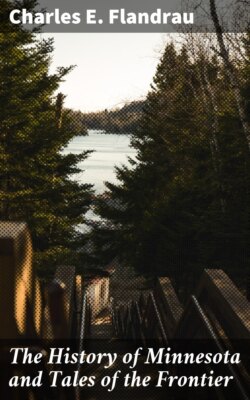Читать книгу The History of Minnesota and Tales of the Frontier - Charles E. Flandrau - Страница 11
На сайте Литреса книга снята с продажи.
SCHOOLCRAFT AND THE SOURCE OF THE MISSISSIPPI.
ОглавлениеTable of Contents
In 1832 the United States sent an embassy, composed of thirty men, under Henry R. Schoolcraft, then Indian Agent at Sault Ste. Marie, to visit the Indians of the Northwest, and, when advisable, to make treaties with them. They had a guard of soldiers, a physician, an interpreter, and the Rev. William T. Boutwell, a missionary at Leech Lake. They were supplied with a large outfit of provisions, tobacco and trinkets, which were conveyed in a bateau. They travelled in several large bark canoes. They went to Fond du Lac, thence up the St. Louis river, portaged round the falls, thence to the nearest point to Sandy lake, thence up the Mississippi to Leech lake. While there, they learned from the Indians that Cass lake, which for some time had been reputed to be the source of the Mississippi, was not the real source, and they determined to solve the problem of where the real source was to be found, and what it was.
I may say here that, in 1819, Gen. Lewis Cass, then governor of the Territory of Michigan, had led an exploring party to the upper waters of the Mississippi, somewhat similar to the one I am now speaking of, Mr. Henry R. Schoolcraft being one of them. When they reached what is now Cass lake, in the Mississippi river, they decided that it was the source of the great river, and it was named Cass lake, in honor of the governor, and was believed to be such source until the arrival of Schoolcraft's party in 1832.
After a search, an inlet was found into Cass lake, flowing from the west, and they pursued it until the lake now called "Itasca" was reached. Five of the party, Lieutenant Allen, Schoolcraft, Dr. Houghton, Interpreter Johnson and Mr. Boutwell, explored the lake thoroughly, and finding no inlet, decided it must be the true source of the river. Mr. Schoolcraft, being desirous of giving the lake a name that would indicate its position as the true head of the river, and at the same time be euphonious in sound, endeavored to produce one, but being unable to satisfy himself, turned it over to Mr. Boutwell, who, being a good Latin scholar, wrote down two Latin words, "veritas," truth, and "caput," head, and suggested that a word might be coined out of the combination that would answer the purpose. He then cut off the last two syllables of veritas, making "Itas," and the first syllable of caput, making "ca," and, putting them together, he gave the word "Itasca," which, in my judgment, is a sufficiently skillful and beautiful literary feat to immortalize the inventor. Mr. Boutwell died within a few years at Stillwater, in Minnesota.
Presumptuous attempts have been made to deprive Schoolcraft of the honor of having discovered the true source of the river, but their transparent absurdity has prevented their having obtained any credence, and to put a quietus on such unscrupulous pretenses, Mr. J. V. Brower, a scientific surveyor, under the auspices of the Minnesota Historical Society, has recently made exhaustive researches, surveys and maps of the region, and established beyond doubt or cavil the entire authenticity of Schoolcraft's discovery. Gen. James H. Baker, once surveyor general of the State of Minnesota, and a distinguished member of the same society, under its appointment, prepared an elaborate paper on the subject, in which is collected and presented all the facts, history and knowledge that exists relating to the discovery, and conclusively destroys all efforts to deprive Schoolcraft of his laurels.
Back to contents
